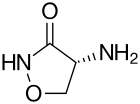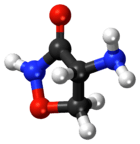Cycloserine
Cycloserine, sold under the brand name Seromycin, is a GABA transaminase inhibitor and an antibiotic, used to treat tuberculosis.[1][2] Specifically it is used, along with other antituberculosis medications, for active drug resistant tuberculosis.[2] It is given by mouth.[2]
 | |
 | |
| Clinical data | |
|---|---|
| Trade names | Seromycin |
| Other names | 4-amino-3-isoxazolidinone |
| AHFS/Drugs.com | Monograph |
| License data |
|
| Pregnancy category |
|
| ATC code | |
| Legal status | |
| Legal status |
|
| Pharmacokinetic data | |
| Bioavailability | ~70% to 90% |
| Metabolism | liver |
| Elimination half-life | 10 hrs (normal kidney function) |
| Excretion | kidney |
| Identifiers | |
| |
| CAS Number | |
| PubChem CID | |
| DrugBank | |
| ChemSpider | |
| UNII | |
| KEGG | |
| ChEBI | |
| ChEMBL | |
| NIAID ChemDB | |
| CompTox Dashboard (EPA) | |
| ECHA InfoCard | 100.000.626 |
| Chemical and physical data | |
| Formula | C3H6N2O2 |
| Molar mass | 102.093 g·mol−1 |
| 3D model (JSmol) | |
| Melting point | 155 to 156 °C (311 to 313 °F) (dec.) |
| |
| |
| (verify) | |
Common side effects include allergic reactions, seizures, sleepiness, unsteadiness, and numbness.[2] It is not recommended in people who have kidney failure, epilepsy, depression, or are alcoholics.[2] It is unclear if use during pregnancy is safe for the baby.[2] Cycloserine is similar in structure to the amino acid D-alanine and works by interfering with the formation of the bacteria's cell wall.[2]
Cycloserine was discovered in 1954 from a type of Streptomyces.[3] It is on the World Health Organization's List of Essential Medicines.[4]
Medical uses
Tuberculosis
For the treatment of tuberculosis, cycloserine is classified as a second-line drug, i.e. its use is only considered if one or more first-line drugs cannot be used. Hence, cycloserine is restricted for use only against multiple drug-resistant and extensively drug-resistant strains of M. tuberculosis. Another reason for limited use of this drug is the neurological side effects it causes, since it is able to penetrate into the central nervous system (CNS) and cause headaches, drowsiness, depression, dizziness, vertigo, confusion, paresthesias, dysarthria, hyperirritability, psychosis, convulsions, and shaking (tremors).[5][6] Overdose of cycloserine may result in paresis, seizures, and coma, while alcohol consumption may increase the risk of seizures.[6] Coadministration of pyridoxine can reduce the incidence of some of these CNS side effects (e.g. convulsions) caused by cycloserine.
Mechanism of action
Cycloserine works as an antibiotic by inhibiting cell-wall biosynthesis in bacteria.[10][11] As a cyclic analogue of D-alanine, cycloserine acts against two crucial enzymes important in the cytosolic stages of peptidoglycan synthesis: alanine racemase (Alr) and D-alanine:D-alanine ligase (Ddl).[11] The first enzyme is a pyridoxal 5'-phosphate-dependent enzyme which converts the L-alanine to the D-alanine form.[11] The second enzyme is involved in joining two of these D-alanine residues together by catalyzing the formation of the ATP-dependent D-alanine-D-alanine dipeptide bond between the resulting D-alanine molecules.[11] If both of these enzymes are inhibited, then D-alanine residues cannot form and previously formed D-alanine molecules cannot be joined together.[11] This effectively leads to inhibition of peptidoglycan synthesis.[11]
Chemical properties
Under mildly acidic conditions, cycloserine hydrolyzes to give hydroxylamine and D-serine.[12][13] Cycloserine can be conceptualized as a cyclized version of serine, with an oxidative loss of dihydrogen to form the nitrogen-oxygen bond.
Cycloserine is stable under basic conditions, with the greatest stability at pH = 11.5.[12]
History
The compound was first isolated nearly simultaneously by two teams. Workers at Merck isolated the compound, which they called oxamycin, from a species of Streptomyces.[14] The same team prepared the molecule synthetically.[15] Workers at Eli Lilly isolated the compound from strains of Streptomyces orchidaceus. It was shown to hydrolyze to serine and hydroxylamine.[16]
Economics
In the U.S., the price of cycloserine increased from $500 for 30 pills to $10,800 in 2015 after the Chao Center for Industrial Pharmacy and Contract Manufacturing changed ownership to Rodelis Therapeutics in August 2015.[17]
The price increase was rescinded after the previous owner, the Purdue University Research Foundation, which retained "oversight of the manufacturing operation" intervened and Rodelis returned the drug to an NGO of Purdue University. The foundation now will charge $1,050 for 30 capsules, twice what it charged before". Eli Lilly has been criticised for not ensuring that the philanthropic initiative continued. Due to US antitrust laws however, no company may control the price of a product after it is outlicensed.[18]
In 2015, the cost in the United States was increased to US$3,150 a month and then decreased to US$1,050 per month.[18]
Research
There is some experimental evidence to suggest that D-cycloserine aids in learning by helping form stronger neural connections.[19] It has been investigated as an aid to facilitate exposure therapy in people with PTSD and anxiety disorders[20][21] as well as treatment with schizophrenia.[22]
References
- Polc, P.; Pieri, L.; Bonetti, E.P.; Scherschlicht, R.; Moehler, H.; Kettler, R.; Burkard, W.; Haefely, W. (1986). "l-Cycloserine: Behavioural and biochemical effects after single and repeated administration to mice, rats and cats". Neuropharmacology. Elsevier BV. 25 (4): 411–418. doi:10.1016/0028-3908(86)90236-4. ISSN 0028-3908. PMID 3012401.
- "Cycloserine". The American Society of Health-System Pharmacists. Archived from the original on 20 December 2016. Retrieved 8 December 2016.
- Gottlieb D, Shaw PD (2012). Mechanism of Action. Springer Science & Business Media. p. 41. ISBN 9783642460517. Archived from the original on 2016-12-20.
- World Health Organization (2019). World Health Organization model list of essential medicines: 21st list 2019. Geneva: World Health Organization. hdl:10665/325771. WHO/MVP/EMP/IAU/2019.06. License: CC BY-NC-SA 3.0 IGO.
- Nitsche MA, Jaussi W, Liebetanz D, Lang N, Tergau F, Paulus W (August 2004). "Consolidation of human motor cortical neuroplasticity by D-cycloserine". Neuropsychopharmacology. 29 (8): 1573–8. doi:10.1038/sj.npp.1300517. PMID 15199378.
- "CYCLOSERINE: Human Health Effects". National Institutes of Health. Archived from the original on 2014-04-16.
- Ori R, Amos T, Bergman H, Soares-Weiser K, Ipser JC, Stein DJ (May 2015). "Augmentation of cognitive and behavioural therapies (CBT) with d-cycloserine for anxiety and related disorders". The Cochrane Database of Systematic Reviews. 5 (5): CD007803. doi:10.1002/14651858.CD007803.pub2. PMID 25957940.
- Schade S, Paulus W (April 2016). "D-Cycloserine in Neuropsychiatric Diseases: A Systematic Review". The International Journal of Neuropsychopharmacology. 19 (4): pyv102. doi:10.1093/ijnp/pyv102. PMC 4851259. PMID 26364274.
- Myers KM, Carlezon WA (June 2012). "D-cycloserine effects on extinction of conditioned responses to drug-related cues". Biological Psychiatry. 71 (11): 947–55. doi:10.1016/j.biopsych.2012.02.030. PMC 4001849. PMID 22579305.
- Lambert MP, Neuhaus FC (June 1972). "Mechanism of D-cycloserine action: alanine racemase from Escherichia coli W". Journal of Bacteriology. 110 (3): 978–87. PMC 247518. PMID 4555420.
- Prosser GA, de Carvalho LP (February 2013). "Kinetic mechanism and inhibition of Mycobacterium tuberculosis D-alanine:D-alanine ligase by the antibiotic D-cycloserine". The FEBS Journal. 280 (4): 1150–66. doi:10.1111/febs.12108. PMID 23286234.
- Kaushal G, Ramirez R, Alambo D, Taupradist W, Choksi K, Sirbu C (October 2011). "Initial characterization of D-cycloserine for future formulation development for anxiety disorders". Drug Discoveries & Therapeutics. 5 (5): 253–60. doi:10.5582/ddt.2011.v5.5.253. PMID 22466372.
- Silverman R (1998). "An Aromatization Mechanism of Inactivation of γ-Aminobutyric Acid Aminotransferase for the Antibiotic l-Cycloserine". Journal of the American Chemical Society. 120 (10): 2256–2267. doi:10.1021/ja972907b.
- Kuehl Jr FA, Wolf FJ, Trenner NR, Peck RL, Buhs RP, Howe E, et al. (1955). "D-4-Amino-3-isoxazolidinone, a new antibiotic". Journal of the American Chemical Society. 77 (8): 2344–5. doi:10.1021/ja01613a105.
- Hidy PH, Hodge EB, Young VV, Harned RL, Brewer GA, Phillips WF, et al. (1955). "Synthesis of D-4-amino-3-isoxazolidinone". Journal of the American Chemical Society. 77 (8): 2346–7. doi:10.1021/ja01613a107.
- Hidy PH, Hodge EB, Young VV, Harned RL, Brewer GA, Phillips WF, et al. (1955). "Structure and reactions of cycloserine". Journal of the American Chemical Society. 77 (8): 2345–6. doi:10.1021/ja01613a106.
- Pollack A (20 September 2015). "Drug Goes From $13.50 a Tablet to $750, Overnight". Archived from the original on 25 September 2015. Retrieved 21 September 2015.
- Pollack A (21 September 2015). "Big Price Increase for Tuberculosis Drug Is Rescinded". NYT. Archived from the original on 26 September 2015. Retrieved 24 September 2015.
- "Learning and Brain Activity Are Boosted by a Dose of a Small-Molecule Compound". Scientific American. Archived from the original on 2015-12-23.
- Bowers ME, Ressler KJ (September 2015). "An Overview of Translationally Informed Treatments for Posttraumatic Stress Disorder: Animal Models of Pavlovian Fear Conditioning to Human Clinical Trials". Biological Psychiatry. 78 (5): E15-27. doi:10.1016/j.biopsych.2015.06.008. PMC 4527085. PMID 26238379.
- Singewald N, Schmuckermair C, Whittle N, Holmes A, Ressler KJ (May 2015). "Pharmacology of cognitive enhancers for exposure-based therapy of fear, anxiety and trauma-related disorders". Pharmacology & Therapeutics. 149: 150–90. doi:10.1016/j.pharmthera.2014.12.004. PMC 4380664. PMID 25550231.
- Goff DC (September 2012). "D-cycloserine: an evolving role in learning and neuroplasticity in schizophrenia" (PDF). Schizophrenia Bulletin. 38 (5): 936–41. doi:10.1093/schbul/sbs012. PMC 3446239. PMID 22368237.